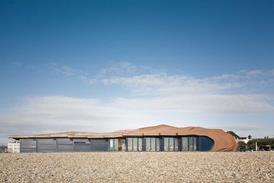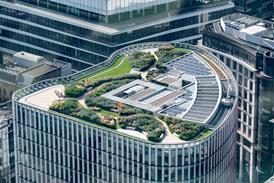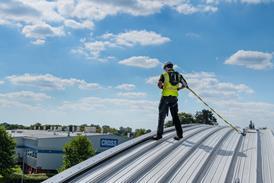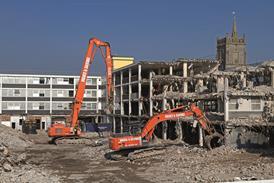- News

All the latest updates on building safety reformRegulations latest
- Focus
Close menu
- Previous slide
- 1 of 7
- Next slide
| Types of concrete frame | ||
| Type | Economic span (m) | Remarks |
| One-way slabs | 4-8 | Economic across a wide range of spans but supporting downstand beams affect the cost, speed of construction and services distribution |
| Flat slabs | 5-9 | Quick and easy to construct. Often the most economic method of construction. Holes require careful detailing |
| Troughed slabs | 6-12 | A slightly greater structural depth, higher formwork costs and longer programme time is offset by the structure’s lighter weight, longer spans and greater adaptability |
| Band beam slabs | 8-15 | Useful for long spans in rectangular panels making them popular for car park construction |
| Two way slabs | 9-12 | Robust construction with large span and load capacities – popular for retail premises and warehouses, but downstand beams disrupt construction and service installation |
| Waffle slabs | 9-14 | Slow to construct but useful for long spans |
| Precast and composite slabs | 4-16 | Economic across a wide range of spans and loads. Increased speed and improved quality on site may be offset by long lead-in times |
| Post-tensioned slabs and beams | 6+ | Insitu slabs and beams. Useful where depth is critical |
| Typical amount of reinforcement allowances | ||
| Suspended slabs | 90-135 kg/m3 | |
| Beams | 250-300 kg/m3 | |
| Columns | 200-300 kg/m3 | |
| Walls | 85-125 kg/m3 | |
| Concrete frame benchmarking: Residential development | |||||
| Project description | Base data | No of storeys | Gross exterior floor area (GEFA) | Cost £m/2 | Package value (approx) |
| Residential apartments (with ground floor retail area) – west London | 1Q01 | 9-15 | 45,970 | 170 | 7,900,000 |
| Mixed use scheme with residential apartments and basement parking – north London | 4Q01 | 12 | 41,727 | 171 | 7,200,000 |
| Residential apartments only – north London | 4Q01 | 7 | 15,113 | 130 | 2,000,000 |
| Residential apartments with private health club – south-west London | 4Q01 | 7-12 | 63,317 | 130 | 8,300,000 |
| Residential apartments with basement parking and retail – Glasgow | 1Q02 | 7-13 | 35,838 | 170 | 6,300,000 |
| Residential apartments with podium parking and retail – east London | 2Q02 | 10 | 40,880 | 147 | 6,100,000 |
| Typical concrete frame rates | |
| City office | £175-206 m2 |
| Office business parks | £140-160 m2 |
| Mixed use scheme | (4-11 storeys) £144-175 m2 |
| Mixed use scheme | (12-20 storeys) £130-150 m2 |
| Typical concrete rates | ||||||
| Concrete mix | Concrete net supply price £/m3 | Prelims % | Overheads and profit % | All in rate for a slab £/m3 | All in rate for a column £/m3 | All in rate for a beam £/m3 |
| C35 | 68 | 20 | 11 | 113 | 118 | 124 |
| C40 | 72 | 20 | 11 | 118 | 123 | 130 |
| C50 | 78 | 20 | 11 | 126 | 131 | 138 |
| C60 | 88 | 20 | 11 | 139 | 144 | 151 |
| Typical reinforcement rates | |||||||
| Ìý | Labour £/t | Material £/t | Waste £/t | Net cost £/t | Prelims £/t | Overheads and profit £/t | Average rate £/t |
| T16 | 250 | 375 | 20 | 645 | 129 | 85 | 859 |
| (average bar size) | |||||||
| Typical formwork rates | ||
| Type of formwork | Cost £/m2 | Remarks |
| Soffit of slabs | 25-40 | Dependent on height, propping requirements and thickness of slabs |
| Permanent shuttering | 20-30 | Dependent on length and gauge of decking |
| Walls | 25-30 | Ìý |
| Beams | 35-40 | Ìý |
| Columns | 30-35 | For square/rectangular |
| Ìý | 35-60 | For circular |
| Specialist concrete contractors | |
| Trade package contracts (£15³¾+) | Annual turnover |
| R. O’Rourke & Sons | £200³¾+ |
| Byrne Bros | £50³¾+ |
| P.C Harrington | £50³¾+ |
| John Doyle Construction | £50³¾ |
| Trade package contracts (£8³¾-15m) | |
| Mitchellson Formwork & Civil Engineering | £30³¾ |
| Getjar | £30³¾ |
| Stephenson Construction | £25³¾ |
| Wheelan & Grant (Contractors) | £12m (Group turnover £30³¾) |
| Trade package contract (up to £8³¾) | |
| C J O’Shea and Company | £30³¾ |
| Duffy Construction | £25³¾ |
| Buildstone | £20³¾ |
| McDermott Bros | £15³¾ |
| Addington (Formwork) | £10³¾ |
| Ascon Contracting | £10³¾ (Group turnover £380m) |
| A J Morrisroe & Sons | £8³¾ |
| Michael J Gallagher Contractors | £6³¾ |
| Silver Construction | £0.5³¾ |
Site powered by















